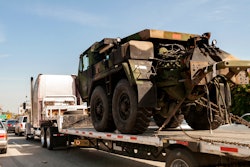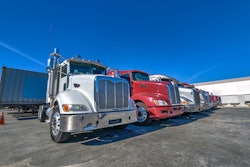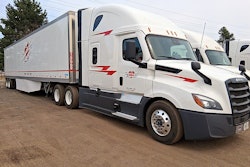Safety has always been a significant area of concern for organizations with transportation fleets. There are many risks associated with operating a heavy-duty truck and this has placed safety front and center as a concern for both the driver and other motorists. It can also significantly affect the financial health and overall reputation of the organizations that employ these drivers.
Even though great advancements have been made in safety features on trucks, safety remains an important topic that will continue to drive organizational focus for many years. Because of this, organizations and their management teams must build into their financial strategies the right capital expenditure and procurement plans to have the newest trucks with advanced safety features on the roads.
Aside from keeping drivers and motorists safe, we know safety is important because of the many stats that illustrate the severity of safety violations and other costs involved. In 2024, the FMCSA collected a total of $27,050,000 in fines from heavy duty fleets. This resulted in an average of $7,100 paid per settlement. Furthermore, 94% of audits resulted in at least one violation, and 24% resulted in fines or other penalties.
What’s more, the costs of out-of-service violations can place an additional financial burden on these organizations. The average revenue loss per out-of-service (OOS) violation for heavy-duty trucks can be estimated to range from $800 to $1,200 per day of downtime. This figure doesn't include other associated costs like fines, repair expenses, or potential reputational damage2. Furthermore, the average insurance cost for safety violations on heavy-duty trucks can range from $2,000 to $5,000 per year, depending on the type of violation and the trucking company's history.
How to reset for a culture of safety
With all this in mind, organizations with transportation fleets should view safety through their organizational culture, not just a talking point during orientation. Culture, in this context, refers to the collective beliefs, values, and practices that shape how safety is perceived and prioritized across all levels of the organization. A strong safety culture is essential because it reaches every aspect of operations, from driver behavior to maintenance practices and compliance with regulations. It is the foundation upon which safe and efficient operations are built.
Establishing the right culture for safety involves a multifaceted approach that starts with commitment from the leadership team. The c-suite must demonstrate a sincere commitment to safety by prioritizing it throughout the entire company, as well as in resource allocation, which includes a strong focus on continually replacing and upgrading aging equipment to leverage the latest truck safety features.
This can be found in the shaping of behaviors, building the right training programs, and actively participating in safety initiatives. Leadership must invest resources and create clear safety policies, procedures and life cycle management of the equipment which are then clearly communicated and enforced to all employees, ensuring that everyone on the team understands their role in maintaining a safe work environment. Regular training and education on safety practices, regulations, and even emergency procedures are also important for keeping all employees updated and prepared.
Open communication for the entire organization is also important for the overall culture. Employees should feel comfortable with self-reporting of any safety concerns, without fear of retribution. There should also be an environment of open dialogue about safety issues, solutions and any changes to safety legislation that impacts the company. Employees should also feel inclined to join a safety task force, which can provide valuable insights and help identify important progress and milestones achieved. Lastly, recognizing and rewarding safe behaviors through incentive programs can motivate employees to prioritize safety in their daily activities.
The role advanced data now plays
Aside from these important company-wide initiatives, organizations should understand the value and role advanced data technology can play in resetting the culture of safety. With access to a wealth of advanced safety, maintenance and violations data inputs, organizations have information that can drive data-driven decision-making and proactive safety measures, especially when evaluating new trucks and driver practices.
Data insights eliminate the excuse of being too swamped to address safety issues. Real-time data on driver behavior, vehicle performance, and compliance metrics enable employees to identify and rectify safety concerns promptly.
Similarly, compliance issues, such as keeping faulty logs, should no longer be an excuse due to the data available. This data can tie directly into ELDs to provide accurate and tamper-proof records of driver hours, reducing the incidence of false log violations. This ensures compliance with regulations and also enhances overall safety by preventing driver fatigue and promoting strict hours-of-service rules.
Relying on a data-forward asset management partner
Some organizations with transportation fleets are not native data analytics professionals, therefore they must work alongside a trusted asset management partner for data analysis, multi-year procurement planning, and safety program development. Having the right multi-year asset procurement strategy can ensure organizations have the right capital expenditure position to make upgrades, regardless of economic conditions.
That being said, today’s leading asset management firms are no longer limited to decisions related to procurement and disposal of trucks. The more advanced firms are also equipped to provide comprehensive insights into truck utilization, maintenance, safety, and violations data, helping organizations make informed improvements to their safety CSA scores. By leveraging data analytics, these trusted partners can identify trends, root causes of safety issues, and areas for improvement, ultimately enhancing fleet safety and operational efficiency.
As part of this, and because of the sophistication of data technology, each truck in a fleet can now be considered its own safety center, with specific safety thresholds and metrics. Advanced telematics systems monitor various aspects of vehicle performance, including speed, braking patterns, and adherence to safety protocols. This detailed level of monitoring allows organizations to set individualized safety benchmarks for each truck, ensuring that every vehicle operates within safe parameters. By treating each truck as a unique safety entity, organizations can tailor their safety strategies to address specific risks and improve overall fleet safety.
Safety for organizations with transportation fleets has been a longstanding issue that will continue to demand attention and action. Recent statistics highlight the significant costs associated with safety violations, emphasizing the need for a robust safety culture. Setting the right culture for safety involves leadership commitment, clear policies, regular training, open communication, and employee involvement.
Today's advanced data provides invaluable insights that can drive proactive safety measures and compliance, eliminating excuses for neglecting safety issues. Asset management partners can add value by leveraging data analytics to enhance fleet safety and operational efficiency. By treating each truck as its own safety center, organizations can set individualized safety benchmarks and improve overall fleet safety. Driving change in the culture of safety is essential for protecting employees, reducing accidents, and ensuring the long-term success of transportation fleets.














